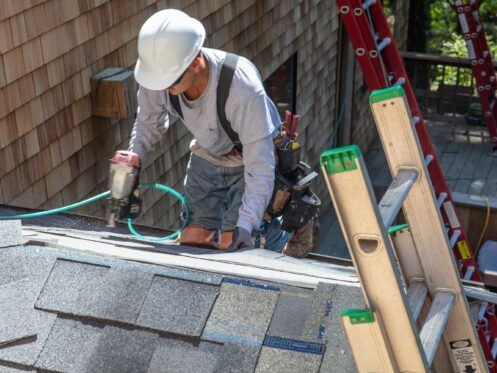Your roof does more than keep you dry — it shapes how your house looks and stands up to the wild weather swings we get in New Jersey and Pennsylvania. Your roof needs to handle everything from snowy winters to heavy spring rains. But when choosing between a flat roof and a pitched one, things can get confusing quickly. Each type has its perks, but each also comes with its own headaches if it’s not right for your home or climate. Flat roofs give modern, clean lines, while pitched roofs offer that classic look with extra water-shedding power.
Picking the right roof replacement isn’t just about style — it’s about what works best where you live. At Warren Thompson & Son Roofing & Siding in Alpha, NJ, we’ve helped homeowners in NJ and PA decide on the best roofing options based on local weather and home designs. Knowing what fits your home can save you time, money, and a lot of future repairs.
How Weather Shapes Your Roofing Needs
Your roof deals with a lot more than just keeping rain out. It’s your home’s shield against snowstorms, heavy winds, and the kind of summer heat that can fry eggs. If you live somewhere with all four seasons, your roof works overtime. You’ve probably noticed that some houses have those steep, classic A-frame roofs, while others have flat, modern-looking designs. That’s not just about style — those shapes are built with weather in mind.
A pitched roof, for example, is built to handle snow. When you get one of those big winter storms that drop a foot of the heavy, wet stuff overnight, a sloped roof helps it slide off. That keeps the weight from building up and pushing down on your home. Flat roofs, on the other hand, don’t shed snow as easily. When snow piles up, it can turn into a heavy blanket, adding stress to your roof and increasing the risk of leaks if water gets trapped as it melts.
Rain is another story. If you get those fast, heavy downpours, a pitched roof directs water quickly into gutters and away from your house. Flat roofs can drain well, too, but they rely on built-in drainage systems. If those get clogged with leaves or debris, you might end up with puddles sitting on your roof. Over time, standing water can weaken the surface and lead to leaks. You might not notice it right away, but a slow drip can turn into a stain on your ceiling, or worse, a sagging section of drywall.
Flat Roofs Offer More Than Just a Modern Look
You’ve probably seen those sleek, flat-roofed homes in magazines or on newer builds around town. They give off a modern vibe and can make a house look bigger and more open. But that flat surface isn’t just for looks. It can actually give you extra space, something you might not think about when choosing a roof.
Some homeowners use their flat roofs as outdoor spaces. You can add a rooftop deck, a garden, or even a seating area. Imagine sipping coffee in the morning or grilling burgers with friends up there. It’s like adding another room to your house without needing more land.
Flat roofs can also make maintenance easier. If you’ve ever had to climb onto a steep roof, you know it can feel like you’re risking life and limb just to clean out the gutters. Flat roofs let you walk around safely, making it easier to check for damage or clear off debris after a storm.
But with that convenience comes a bit of responsibility. You’ll need to check your roof more often. Because it doesn’t naturally shed water, leaves, and sticks like a pitched roof, you’ll need to make sure drains stay clear. It’s not a huge chore, but it’s one you can’t skip unless you want to deal with leaks later.
Pitched Roofs Are Long-Lasting
When you picture a classic home, chances are you’re thinking of one with a pitched roof. There’s a reason that style has been around for centuries — it works well. Those steep slopes aren’t just there to look pretty; they’re designed to handle just about anything nature throws at them.
Heavy snow is one of the biggest reasons pitched roofs are so popular in colder areas. Snow slides off naturally, keeping the weight from building up. That protects your home’s structure and reduces the risk of ice dams. If you’ve ever had an ice dam, you know it can lead to water stains inside your house and even damage your walls.
Pitched roofs also give you more attic space. Even if you don’t use it for storage, that extra air above your ceilings can help with insulation. In the winter, it keeps your house warm, and in the summer, it keeps it cool. That can cut down on your energy bills and make your house feel more comfortable year-round.
The Cost Factor
Let’s be honest — cost is often the deciding factor when you’re thinking about any home improvement project. Roofing is no different. You might hear that flat roofs are cheaper, and sometimes that’s true, but it’s not always that simple.
Flat roofs are often less expensive to put in because they need fewer materials and can be built faster. There’s no complex framing, and the labor is often quicker. That can be appealing if you’re on a tight budget or building an addition.
But flat roofs can cost more over time. They usually don’t last as long as pitched roofs. Depending on the material, you might need to replace a flat roof every 15 to 25 years. Pitched roofs, especially those with shingles or metal, can last 30 years or more with proper care.
Repairs can also add up. When drainage isn’t good, water tends to pool on flat roofs, making them more likely to leak. Fixing a small leak early can save you money, but ignoring it can lead to more serious and expensive damage.
Pitched roofs have their own expenses. Because of their height and slope, repairs can take longer and require more safety equipment. However, their durability often means fewer repairs overall, which can balance out the higher installation cost.
Pick the Right Roof for Your Home
When it comes down to it, the right roof for your home depends on a few key things: your style, your budget, and how much maintenance you’re willing to do. But climate should also play a big role in your decision.
If you live somewhere with heavy snow or frequent rain like in NJ and PA, a pitched roof can give you peace of mind. You won’t have to worry as much about water pooling or snow piling up. You might pay more up front, but you’ll likely save on long-term repairs and replacements.
If you love the look of a flat roof and are willing to keep up with regular maintenance from an expert roofing services company, it can work well, especially if you want that extra outdoor space. Make sure to keep up with cleaning the drains and checking for leaks. A flat roof can handle the weather just fine as long as you give it the attention it needs.
Call Us Today
Choosing between a flat or pitched roof can feel like a tough call, but when you think about your home’s style, your long-term plans, and the challenges that come with NJ’s and PA’s weather, the right choice starts to stand out. A roof that suits your home and climate doesn’t just look good — it protects what matters most.
If you’re ready to explore the best roofing solution for your home, call Warren Thompson & Son Roofing & Siding today.

